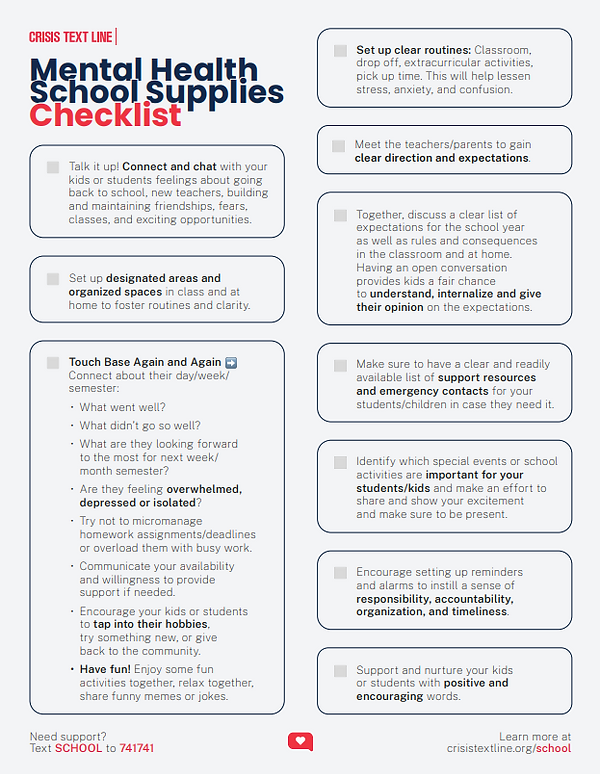Conciencia y Bienestar de la Salud Mental
Identificación y respuesta a las necesidades de salud mental de los jóvenes (IRY)

Back to School;
Thinking about Mental Wellbeing
Starting School and Feeling Nervous? You’re Not Alone.
As the school year begins, it’s natural to feel a mix of emotions—excitement, curiosity, and yes, even anxiety. Whether you're a student stepping into a new classroom, a parent sending your child off to school, or an educator preparing to welcome new faces, nerves are a normal part of the transition.
You’re not alone—and there are healthy ways to cope. Simple steps like establishing routines, getting enough sleep, and talking openly about your feelings can make a big difference. For educators and caregivers, offering a calm, supportive presence can help young people feel safe and seen.
This season, let’s be gentle with ourselves and others. New beginnings take courage—and that courage grows with connection and support.

Insights from Emory’s State of Child Health and Well‑Being (2025):
-
Around 15% of Georgia children have a formal diagnosis of anxiety or depression.
-
Another 17% are suspected by their parents to have undiagnosed anxiety—suggesting up to 32% of children may be affected.
-
63% of diagnosed children are not receiving mental health services.
Learn more https://sph.emory.edu/news/child-health-well-being-georgia
La salud mental incluye el bienestar mental, emocional y conductual.
Según los CDC, los problemas de ansiedad, los problemas de conducta, el TDAH y la depresión son los trastornos mentales más comúnmente diagnosticados en los niños. Muchos factores familiares, comunitarios y de atención médica están relacionados con la salud mental de los niños. La conciencia de la comunidad sobre las enfermedades mentales es importante para reducir el estigma.
Nuestro objetivo es aumentar el bienestar de la salud mental al aumentar la capacidad de los primeros auxilios para identificar y responder adecuadamente a los jóvenes (de 12 a 18 años) que pueden estar experimentando problemas de salud mental y/o trastornos emocionales.


The Substance Abuse and Mental Health Services Administration describes mental health as our emotional, psychological, and social well-being that can affect how we think, feel, and act. We all have mental health, just as we all have physical health. It is essential to understand the difference between mental health and mental health conditions. Mental health conditions are illnesses or disorders that can range from mild to severe (schizophrenia, major depression, etc.). There are various factors that can contribute to mental health conditions including biology, life experiences, and family history.
The Center for Disease Control and Prevention (CDC) reports that more than 1 in 5 youth between the ages of 13-18 either currently or at some points of their life have been diagnosed with a mental illness. There is evidence that adverse childhood experiences (ACEs) are related to poor mental health later in life. ACEs are traumatic events that occur in a child’s life including experiencing or witnessing violence in their home or community. They can have lasting, negative effects on childhood well-being and life opportunities. ACEs can be prevented using different strategies such as ensuring a positive support system for children, teaching coping skills, and connecting youth to caring adults and activities. Watch this video to learn more about ACEs and how you can help the youth around you.

You can bring awareness to mental health by promoting mental health education in schools and workplaces, organizing mental health awareness events and activities in the community, share personal stories about lived experiences to provide hope and reduce stigma, and encourage open communication about mental health with your friends and family. Mental Health America has created a toolkit with great resources for promoting mental health in your home and community. These include:
-
Shareable social media images
-
Mental health fact sheets
-
Coping tools
-
Outreach ideas


Primeros auxilios de salud mental para jóvenes

Identificar. Entender. Responder.
Los Primeros Auxilios para la Salud Mental de los Jóvenes están diseñados para enseñar a los padres, familiares, cuidadores, maestros, personal escolar, compañeros, vecinos, trabajadores de servicios humanos y de salud y otros ciudadanos solidarios cómo ayudar a un adolescente (de 12 a 18 años) que está experimentando una la salud mental o las adicciones son un desafío o están en crisis. Los Primeros Auxilios para la Salud Mental de los Jóvenes están diseñados principalmente para adultos que interactúan regularmente con jóvenes.
El curso presenta desafíos comunes de salud mental para los jóvenes, revisa el desarrollo típico de los adolescentes y enseña un plan de acción de 5 pasos sobre cómo ayudar a los jóvenes en situaciones de crisis y de no crisis. Los temas cubiertos incluyen ansiedad, depresión, uso de sustancias, trastornos en los que puede ocurrir psicosis, trastornos del comportamiento perturbador (incluido el TDA/H) y trastornos de la alimentación.
En asociación con más de 1600 marcas, organizaciones sin fines de lucro, agencias gubernamentales y líderes culturales, estamos orgullosos de ser socios en el Día de Acción de Salud Mental, el jueves 19 de mayo. En este día, alentaremos y empoderaremos a las personas para que den el siguiente paso hacia #MentalHealthAction . Ir a MentalHealthActionDay.org para obtener más información y unirse a nuestro esfuerzo para pasar de la conciencia a la acción sobre la salud mental.

Kit de herramientas comunitarias para aumentar la resiliencia | fuerte4vida
Use estos puntos de conversación cuando discuta la campaña Raising Resilience con las partes interesadas clave y los miembros de los medios. Acerca de Strong4Life. Con el respaldo de expertos clínicos, de seguridad y de salud del comportamiento aquí en Children's, Strong4Life tiene la misión de ayudar a los padres y cuidadores a criar niños sanos, seguros y resilientes.
Haga clic en el siguiente enlace


Ponerse en contacto
Universidad Estatal de Georgia
Si tiene preguntas, envíe un correo electrónico a Michelle Quintero @ mquintero@gsu.edu